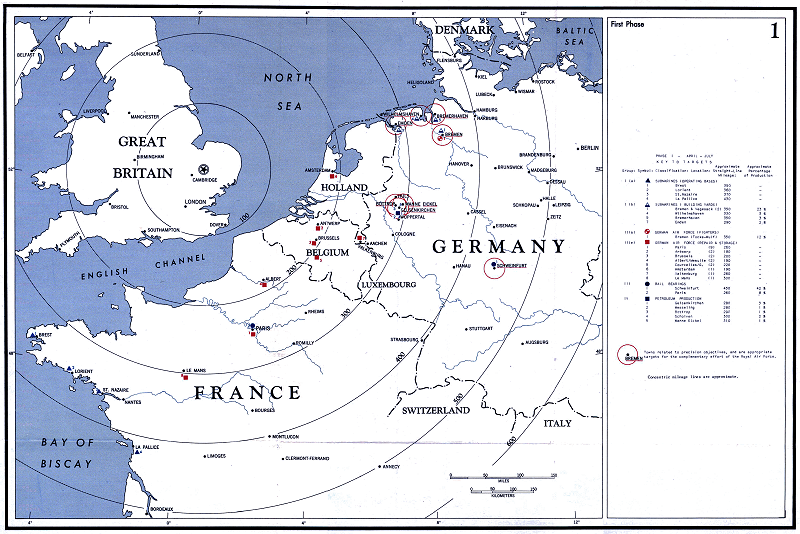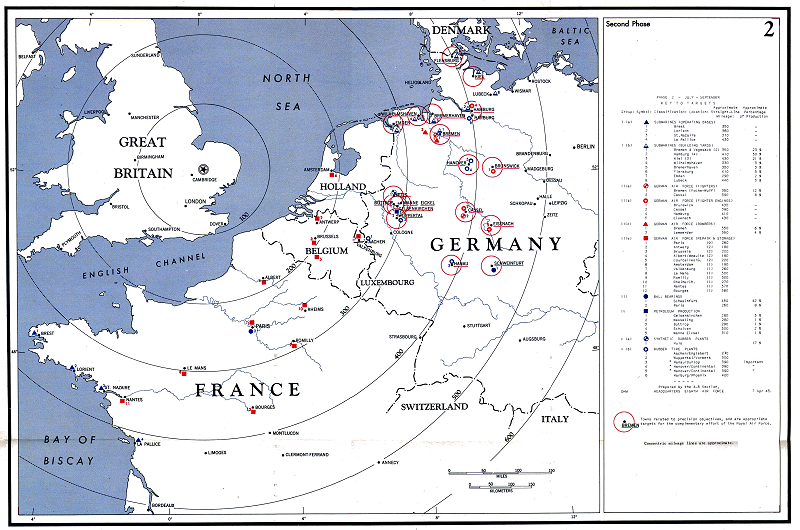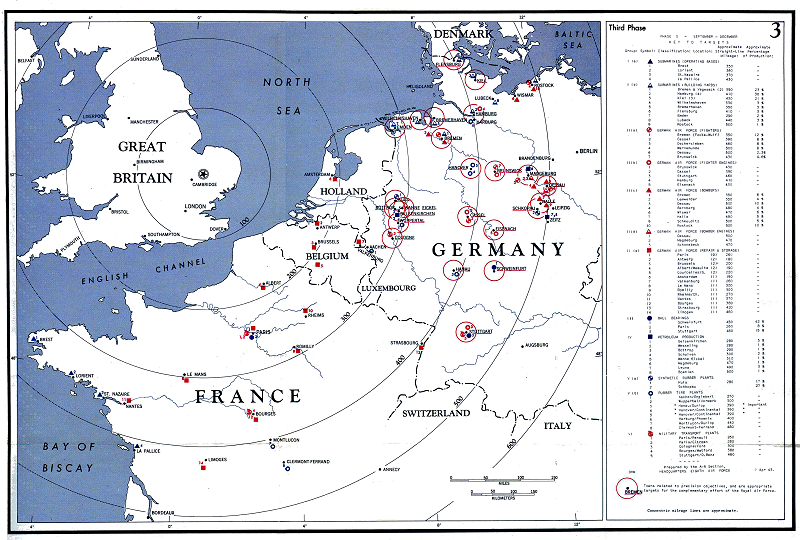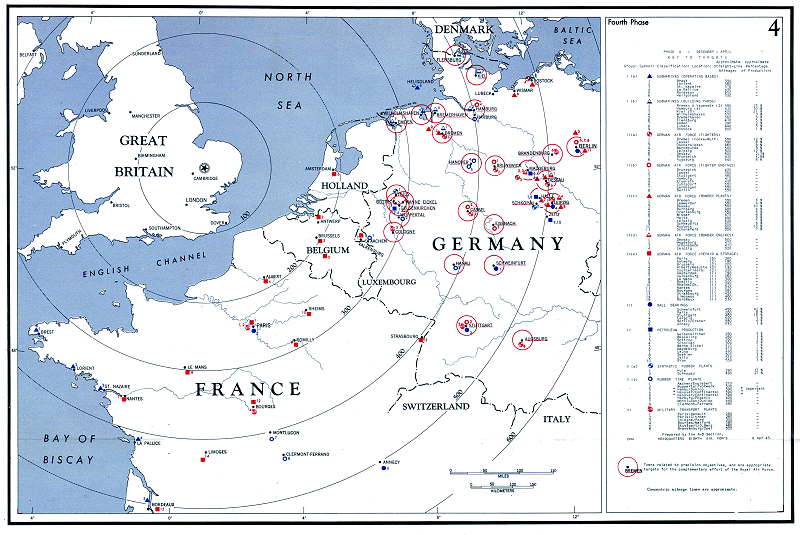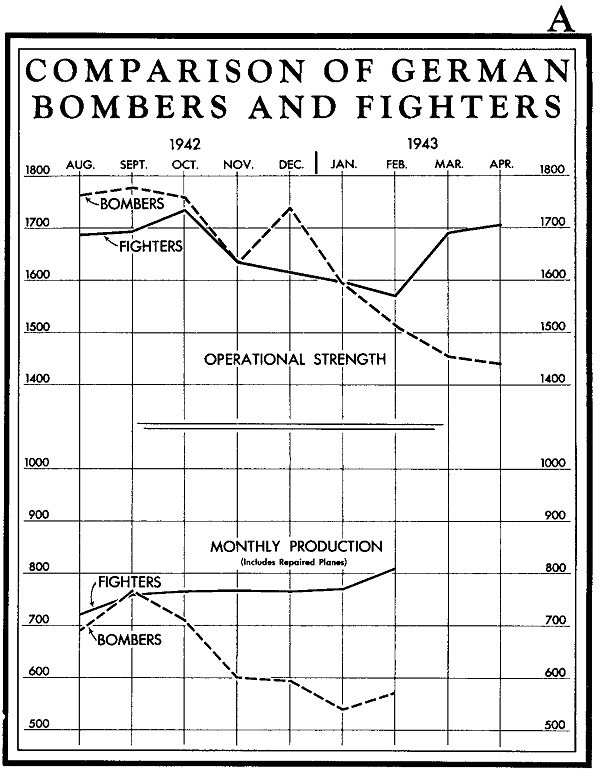
|
U. S. SECRET
BRITISH MOST SECRET
PLAN FOR COMBINED BOMBER OFFENSIVE
FROM THE
UNITED KINGDOM
References:
CCS 85th Meeting Minutes, Item (4)
CCS 87th
Meeting Minutes, Item (7)
4th White House Meeting Minutes, Item
(2)
C.C.S. 217 was circulated 15 May 1943 to the Combined Chiefs of Staff.
This paper was considered by the Combined Chiefs of Staff and the recommendations contained herein were approved in their 87th Meeting.
– – – – – – – – – – – – – – – – – – – – – – – – – – – – –
U. S. SECRET
BRITISH MOST SECRET
C.C.S. 217
14 May 1943
PLAN FOR COMBINED BOMBER OFFENSIVE
FROM THE
UNITED KINGDOM
Note by the Secretaries
The attached plan for a combined bomber offensive from the UNITED KINGDOM meets with the approval of the United States Chiefs of Staff, and is submitted for the consideration of the Combined Chiefs of Staff.
H. REDMAN,
J. R. DEANE,
Combined Secretariat.
1. PROBLEM: To provide a plan to accomplish, by a combined U. S.-British air offensive, the “progressive destruction and dislocation of the German Military, industrial, and economic system, and the undermining of the morale of the German people to a point where their capacity for armed resistance is fatally weakened;” as directed by the Combined Chiefs of staff at CASABLANCA.
2. Under the direction of the Commanding General, European Theater of Operations, a plan to accomplish the above objective in early 1944 has been prepared. The complete plan is on file with the Secretary, U. S. Chiefs of Staff. A brief presentation of the plan is contained in Enclosure “B”.
3. Representatives of the R.A.F. collaborated in the preparation of this plan which has been approved by the British Air Ministry (See Enclosure “A”).
4. The plan establishes requirements for U. S. aircraft in the UNITED KINGDOM as follows:
|
|
Heavy Bombers |
Medium Bombers |
|
By 30 June 1943 |
944 |
200 |
|
By 30 September 1943 |
1,192 |
400 |
|
By 31 December 1943 |
1,746 |
600 |
|
By 31 March 1944 |
2,702 |
800 |
5. The Present U.S. Army Air Forces expansion program provides the air units and aircraft necessary to implement the above program, after provision has been made for meeting all present and planned undertakings in other theaters with reasonable balance in estimated aircraft production for unforeseen contingencies that may arise.
6. IT IS RECOMMENDED:
That the Combined Chiefs of Staff approve the “Plan for Combined Bomber Offensive from the UNITED KINGDOM,” presented in Enclosure “B” and direct its implementation to the maximum extent practicable, consistent with meeting aircraft production objectives, with the availability of combined shipping, and with proper relationship to strategic objectives given in Item 5, Minutes, Combined Chiefs of Staff, 76th Meeting.
– – – – – – – – – – – – – – – – – – – – – – – – – –
AIR MINISTRY,
King Charles
Street,
Whitehall, S.W.1.
15th April, 1943
My dear Arnold,
As you know, the Eighth Air Force has been engaged with the Air Staff in drawing up a detailed plan for the purpose of discharging the responsibilities laid upon our combined bomber forces at the Casablanca Conference.
The plan is now complete. It is based on our combined resources in the matter of intelligence and operational data including the very valuable report of your Operations Analysts and has been drawn up in close consultation with the Ministry of Economic Warfare.
I have carefully examined the plan and discussed it in all its aspects with the Commanding General, Eighth Air Force. I take this opportunity of saying that I believe it to be entirely sound and that it has my full support.
The plan includes an estimate of the rate at which the strength of the Eighth Air Force must be developed in order to achieve the planned effect. I believe this rate of build-up and the time factor generally to be of primary importance. The German Fighter strength is increasing rapidly and every week’s delay will make the task more difficult to accomplish. We cannot afford to miss the good bombing weather which will soon be due. We cannot exploit to the full the great potentialities of the daylight bombing technique if the requisite numbers are not available.
For all these reasons I earnestly hope that every effort will be made to achieve and if possible to exceed the programme.
The plan has been carefully examined by the Commander in Chief, Bomber Command, and he too is convinced of its soundness and importance.
With best wishes,
Yours sincerely,
/S/
C. Portal
– – – – – – – – – – – – – – – – – – – – – – – – – –
1. THE MISSION
a. The mission of the U. S. and British bomber forces, as prescribed by the Combined Chiefs of Staff at CASABLANCA, is as follows:
To conduct a joint U. S.-British air offensive to accomplish the progressive destruction and dislocation of the German Military, industrial, and economic system and the undermining of the morale of the German people to a point where their capacity for armed resistance is fatally weakened. This is constructed as meaning so weakened as to permit initiation of final combined operations on the Continent.
2. THE PRINCIPAL OBJECTIVES
a. A thorough study of those elements of the German Military, industrial, and economic system which appeared to be profitable as bombing objectives was made by a group of Operations Analysts consisting of eminent U. S. experts. The report of the Operations Analysts concludes that:
The destruction and continued neutralization of some sixty (60) targets would gravely impair and might paralyze the western AXIS war effort. There are several combinations of targets from among the industries studied which might achieve this result.
b. Examination of this report shows complete agreement by U. S. and British experts. From the systems proposed by the Operations Analysts, six systems, comprising seventy-six (76) precision targets have been selected. These targets are located within the tactical radius of action of the two air forces, and their destruction is directed against the three major elements of the German Military machine: its submarine fleet, its air force, and its ground forces, and certain industries vital to their support.
c. The six systems are:
Submarine construction yards and bases.
German aircraft industry.
Ball bearings.
Oil.
Synthetic rubber and tires.
Military transport vehicles.
Concentration of effort against these systems will have the following effect. The percentage of destruction is as indicated by the Operations Analysts.
(1) Submarine Construction Yards and Bases
Destruction of the submarine building yards selected will reduce present submarine construction by eighty-nine percent (89%). Attack of submarine bases will affect the submarine effort at sea. If it is found that successful results can be achieved, these attacks should continue whenever conditions are favorable for as long and as often as is necessary.
(2) German Aircraft Industry
Depletion of the German Air Force will fatally weaken German capacity to resist our air and surface operations. Complete domination of the air is essential for our ultimate decisive effort. Destruction of forty-three percent (43%) of the German fighter capacity and sixty-five percent (65%) of the German bomber capacity is provided for in this plan, and will produce the effect required.
(3) Ball Bearings
The critical condition of the ball bearing industry in GERMANY is startling. The concentration of that industry renders it outstandingly vulnerable to air attack. Seventy-six percent (76%) of the ball bearing production can be eliminated by destruction of the targets selected. This will have immediate and critical repercussions on the production of tanks, airplanes, artillery, diesel engines - in fact, upon nearly all the special weapons of modern war.
(4) Oil
The quantities of petroleum and synthetic oil products now available to the German is barely adequate to supply the life blood which is vital to the German war machine. The oil situation is made more critical by failure of the Germans to secure and retain the Russian supplies. If the PLOESTI refineries, which process thirty-five percent (35%) of current refined oil products available to the AXIS are destroyed, and the synthetic oil plants in GERMANY which process an additional thirteen percent (13%) are also destroyed, the resulting disruption will have a disastrous effect upon the supply of finished oil products available to the AXIS.
(5) Synthetic Rubber and tires
These products are vital to all phases of German Military strength on land and in the air. Provision is made for destruction of fifty percent (50%) of the synthetic rubber capacity and nearly all of the tire production. This destruction will have a crippling effect.
(6) Military Transport Vehicles
Seven (7) plants produce a large proportion of the military transport and armored vehicles. The precise proportion in unknown. Loss of these plants will strike directly at the German Military strength. The cumulative effect of the destruction of the targets comprising the systems just listed will fatally weaken the capacity of the German people for armed resistance.
d. The selection of these objectives is confirmed by the fact that the systems about which the Germans are most sensitive and about which they have concentrated their defenses such as balloons, camouflage, anti-aircraft, searchlights, decoys, and smoke are:
Aircraft factories.
Submarine construction yards.
Ball bearings.
Oil.
3. INTERMEDIATE OBJECTIVE
a. The Germans, recognizing the vulnerability of their vital industries, are rapidly increasing the strength of their fighter defenses. The German fighter strength in western EUROPE is being augmented. If the growth of the German fighter strength is not arrested quickly, it may become literally impossible to carry out the destruction planned and thus to create the conditions necessary for ultimate decisive action by our combined forces on the Continent.
b. Hence the successful prosecution of the air offensive against the principal objectives is dependent upon a prior (or simultaneous) offensive against the German fighter strength.
c. To carry out the Eighth Air Force’s part of this combined bomber offensive it will be necessary to attack precision targets deep in German territory in daylight. The principal obstacle to this is the growing strength of the German Air Force. The growth of this fighter force has become so pronounced as to warrant a brief review of this development (Chart A).
d. The upper curve shows what has been happening to the German Air Force in the past nine months. The bomber strength has been sharply reduced from 1760 bombers to 1450 in operational units. The fighters, on the other hand, increased from 1690 to 1710. They suffered a reduction in strength doubtless caused by the intense operations in RUSSIA and the MEDITERRANEAN as well as in the Western Front, but those losses have been made good at the expense of the bombers. That same trend is reflected in the lower curve, which shows production was maintained fairly constantly for about five months and then increased so that fighter production has risen from 720 to 810 per month. Over a longer period of time, from the entrance of the U.S. into the war until the present time, the trend has been even more pronounced. German fighter strength has increased by forty-four percent (44%) in that period in spite of the heavy losses. This chart shows the margin of production over average monthly wastage in German fighters. Of course, the monthly wastage has not been constant over the past seven months, as shown on the chart, but the average for that period has been fairly accurately determined at 655 fighters per month. The production rate as of last February showed 810 fighters per month. The average increase in production over the six month period depicted indicates a monthly surplus of production over average wastage of 108 airplanes. If this trend simply continues in its present ratio, it is well within the capacity of the Germans to produce enough fighter airplanes over and above wastage to provide a strength of 3,000 fighters by this time next year. (See Chart D). This is, of course, a capability and not necessarily a German intention, although current German development points very strongly in that direction. The increase in fighter strength is not reflected in this curve covering the past eight months; however, during that period the Germans diverted a great many fighter type airplanes into fighter bombers and fighter reconnaissance airplanes. The wastage rate was very high in those units and that probably accounts for the temporary decline in German fighter strength; however, in the last three months it has shown a sharp uprise.
e. The disposition of German fighters is also significant. (See Chart C). The top line shows the number of fighters on the Western Front. Since we entered the war, that strength has nearly doubled. It has risen from 420 to 830. This, in spite of the heavy drains on the Russian and MEDITERRANEAN Fronts. When we entered the war only thirty-six percent (36%) of German fighters were concentrated on the Western Front; today, fifty percent (50%) of all fighters available to the German Air Force are concentrated in opposition to our principal bombing effort from the United Kingdom. The German fighter force is taking a toll of our forces both by day and by night, not only in terms of combat losses but more especially in terms of reduced tactical effectiveness. If the German fighters are materially increased in number it is quite conceivable that they could make our daylight bombing unprofitable and perhaps our night bombing too. On the other hand, if the German fighter force is partially neutralized our effectiveness will be vastly improved.
f. For this reason German fighter strength must be considered as an Intermediate objective second to none in priority.
4. INTEGRATED R.A.F. – U.S. ARMY AIR FORCES OFFENSIVE
a. The combined efforts of the entire U-.S. and British bomber forces can produce the results required to achieve the mission prescribed for this theater. Fortunately the capabilities of the two forces are entirely complementary.
b. The tremendous and ever increasing striking power of the R.A.F. bombing is designed to so destroy German material facilities as to undermine the willingness and ability of the German worker to continue the war. Because of this, there is great flexibility in the ability of the R.A.F. to direct its material destruction against those objectives which are closely related to the U. S. bombing effort which is directed toward the destruction of specific essential industrial targets. It is considered that the most effective results from strategic bombing will be obtained by directing the combined day and night effort of the U.S. and British bomber forces to all-out attacks against targets which are mutually complementary in undermining a limited number of selected objective systems. All-out attacks imply precision bombing of. related targets by day and night where tactical conditions permit, and area bombing by night against the cities associated with these targets. The timing of the related day and night attacks will be determined by tactical considerations.
c. This plan does not attempt to prescribe the major effort of the R.A.F. Bomber Command. It simply recognizes the fact that when precision targets are bombed by the Eighth Air Force in daylight, the effort should be complemented and completed by R.A.F. bombing attacks against the surrounding industrial area at night. Fortunately the industrial areas to be attacked are in most cases identical with the industrial areas which the British Bomber Command has selected for mass destruction anyway. They include HAMBURG, BREMEN, HANOVER, BERLIN, LEIPZIG, WILHELMSHAVEN, BREMERSHIRE, COLOGNE, STUTTGART, and many other principal cities. They also, of course, include smaller towns whose principal significance is coupled with the precision targets prescribed for the Eighth Air Force.
5. GENERAL PLAN OF OPERATIONS
a. It would be highly desirable to initiate precision bombing attacks against German fighter assembly and engine factories immediately. However, our present force of day bombers is too small to make the deeper penetrations necessary to reach the majority of these factories. Considering the number of German fighters which can be concentrated laterally to meet our bombers on penetration, and again on withdrawal, it is felt that 300 heavy bombers is the minimum operating force necessary to make deep penetrations.
b. The general tactical plan of operations with this minimum force involves the following general conception. A holding attack intending to attract German fighters to a particular area and prevent their massing against the main attacking force. For this purpose 50 heavy bombers with fighter escort are required. Second, a main striking force to penetrate through the fighter defenses and carry out the destruction of targets in Germany and return. Two hundred bombers is considered the minimum requirement to provide self-protection and at the same time carry out worthwhile destruction. Third, the covering force to attack still another area and attract fighters in order to divert them from the main force on withdrawal. Again, 50 bombers with fighter escort is the minimum force to carry out such a function .
c. In order to establish a yardstick to be used in the determination of the number of bombers required to destroy the objectives desired, the following procedure was employed:
Twelve successful missions were conducted in January, February, and March. Approximately 100 bombers were dispatched on each. It was found that sufficient bombs fell within a circle of 1000 foot radius centered about the aiming point to cause the desired destruction. For each prospective target the number of 1000 foot radius circles necessary to cover it has been calculated. The yardstick as determined by experience is therefore: the number of 1000 foot radius circles of destruction, each requiring 100 bombers.
d. The plan of operations is divided into four phases. (See Maps 1, 2, 3, & 4). The depth of penetration, the number of targets available, and the capacity of the bombing forces increases successively with each phase.
e. Seventy-six precision targets have been selected for Eighth Air Force bombing operations. Having selected these 76 targets the questions arise: Can they be effectively destroyed, and if so, how many bombers will be required? As to the first question, operational experience answers yes.
6. EFFECTIVENESS OF EIGHTH AIR FORCE
a. The operations of the U.S. Army Air Force in daylight bombing of defended objectives in German occupied EUROPE have been sufficient to establish a criterion of precision daylight bombing effectiveness; the operations of the R.A.F. Bomber Command leave no room for doubt of the ability of that force to devastate industrial areas.
b. The daylight operations of the Eighth Air Force from 3 January 1943 to 6 April 1943 definitely establish the fact that it is possible to conduct precision pattern bombing operations against selected precision targets from altitudes of 20,000 feet to 30,000 feet in the face of anti-aircraft artillery and fighter defenses.
c. Of 20 missions dispatched by the U.S. Eighth Air Force in that period, 12 have been highly effective. These 12 daylight missions have been directed against a variety of targets, including:
Submarine bases.
Locomotive shops.
Power houses.
Marshalling yards.
Shipbuilding yards.
Motor vehicle and armament works
Airplane engine factories.
The average number of aircraft dispatched against these targets has been eighty-six. The destructive effect has, in every case, been highly satisfactory. From this experience it may be definitely accepted that 100 bombers dispatched on each successful mission will provide entirely satisfactory destructive effect of that part of the target area within 1000 feet of the aiming point; and that two-thirds of the missions dispatched each month will be successful to this extent.
7. FORCES REQUIRED
a. Heavy Bombers
(1) In computing the force required, a yardstick of 100 bombers dispatched per target area of 1000 feet about each aiming point has been accepted as a reasonable product of actual experience to date. Each target has been evaluated in terms of these Target Units, or the number of 1000 foot radius circles in which this destructive effect must be produced.
(2) Experience in the European Theater to date indicates that at least 800 airplanes must be in the theater to dispatch 300 bombers on operations. Hence, until the level of U.S. bomber strength in this theater reaches approximately 800, it will not be feasible to sustain a precision bombing offensive against the German fighter factories. It is estimated that we will be able to accommodate and train a force of this capacity by July of this year. In the interim every effort should be made to reduce the German fighter force by attack of those fighter factories which can be reached, and by combat under favorable conditions. The repair depots and airdromes are included for the purpose of giving commanders the necessary tactical latitude. Concurrently, operations can be conducted against submarine installations within reach and against other targets contributing directly to the principal objectives which are within covering range of our own fighters, or which do not require deep penetration. Some operations will have to be conducted to provide the necessary training for the incoming forces; such operations must be conducted against objectives within the listed categories.
(3) During the next phase, from July to October, in which it is estimated that we will be able to penetrate to a limit of 400 miles, a determined effort must be made to break down the German fighter strength by every means at our disposal, concentrating primarily upon fighter aircraft factories. During this time interim an additional increment of 258 bombers is required so that the strength in the theater by October should be approximately 1192. This would provide a striking force of 450 bombers at the end of this period. The average striking force during this period would be 400.
(4) During the third phase, the German fighter force must be kept depleted, and the other sources of German strength must also be undermined. During this phase our bombing offensive forces must be adequate to perform all their major tasks.
(5) From October to January an additional increment of 554 bombers is required, bringing the total to 1746. This should provide an operational striking force of 655 bombers at the end of that time. The average striking force during this period will be 550 bombers.
(6) During the last phase - early 1944 - the entire force should be used to sustain the effect already produced and to pave the way for a combined operation on the Continent. This will require a force of 2702 heavy bombers.
(7) It will be observed that the charts of the actual location of the targets to be attacked in each phase show the joint bombing effort of each phase. It will be noted that in the first phase (see Map 1), operations are limited to relatively shallow penetration. They include submarine bases along the coast, submarine construction yards, and the Focke Wulf airplane factory at BREMEN. Actually, of course, these operations have all been undertaken with the small forces available and in the case of the submarine yards at VEGESACK and the Focke Wulf plant at BREMEN, a long step has already been taken toward completion of the plan. There are two other systems of operations calling for deep penetrations shown in this phase. One of them calls for an attack against oil installations in the RUHR. This operation is entirely contingent upon an earlier attack from the MEDITERRANEAN Area against the oil refineries at PLOESTI in RUMANIA. Such an attack is under consideration now and if it is carried out we will be forced to operate against the RUHR refineries in order to exploit the advantage achieved in RUMANIA. The other attack calls for a very deep penetration at SCHWEINFURT. This operation might be undertaken as a surprise attack in view of the tremendous advantages accrued from a successful destruction of these plants; however, it would be most unwise to attempt it until we are perfectly sure we have enough force to destroy the objective in a single operation. Any attempt to repeat such an attack will meet with very bitter opposition. In the second phase (see Map 2), the plan calls for a concentration of effort against the German fighter assembly and fighter aircraft factories as well as attacks against airdromes and repair facilities. It is anticipated that approximately 75% of the striking force will be applied to this end during this phase. The other 25% is directed against submarine construction yards. In the third phase (see Map 3), an all-out attack against all the principal objectives is provided as well as repeat operations to continue neutralization of installations which have been destroyed and which can be repaired. During the fourth phase (see Map 4), these operations are continued and allowances made for concentration of attacks against installations more directly associated with a cross-Channel operation such as rail transportation, arsenals, Military installations, etc.
(8) The determination of the number of aircraft required in each phase has been based strictly upon past experience. As to rate of operations, the Eighth Air Force has averaged six per month over the past six months. In the past three months, it has actually carried out twelve highly successful operations out of a total of 20. This plan is based on a total of 12 successful operations in each three month phase and recognizes the probability that the other six will for one reason or another be less satisfactory. Experience has shown that about 3/8 of the total number of airplanes in the theater can be dispatched on operational missions at any one time. This makes allowances for the airplanes in depot reserve, those in depot repair, and those being ferried and modified. There is every reason to believe that our forces will be more effective in the future than these figures indicate. In order to be as realistic as possible, however, the plan has been based in each case upon actual past experience.
(9) Charts appended to Maps 1, 2, 3, and 4 tabulate all the targets for contemplated destruction by the U. S. and British bomber forces to carry out the mission. The precision targets for attacks by the U. S. Bomber Command are shown as small symbols. The cities and towns in or near those precision targets and which constitute the complementary targets of the R.A.F. are shown as in circles. The German fighters are at present deployed in four main concentrations positioned well forward toward the coast. In general, the day fighters are in four lots of approximately 100 each in the general areas of northwest coastal GERMANY, HOLLAND and BELGIUM, the Channel coast of FRANCE and western FRANCE in the vicinity of the submarine pens. These fighters are capable of concentrating laterally from bases at least 200 miles away so that forces of 300 fighters might be employed against our main efforts if we penetrated directly toward the RUHR without distracting or diverting part of them.
(10) Chart D is illustrative of the effect of this plan of operations upon the intermediate objective, German fighter strength. This chart must be considered as pictorial rather than precise. The top line shows the increase in German fighter strength. That is a German capability if they choose to follow it. If German production is not interrupted and if German wastage is not increased it is possible for GERMANY to have in operation 3,000 fighters by next April. The broken line shows the effect of our operations upon that German fighter strength. In the first phase we do not expect to accomplish a great deal because our forces will not have been built up to decisive proportions. In the second phase, our attacks against German fighter factory and engine factories and the increased attrition should cause the levelling off of the German fighter strength. In the third phase the full effect of the attacks against German fighter production should make themselves felt so that German fighter strength should fall off rapidly in this phase. In the fourth phase that German fighter strength should decline at a precipitant rate. This second line has been computed in the following manner. The decrease in German fighter strength is the result of two factors. One is the attacks against German fighter factories, the other the accelerated rate of combat wastage caused by our increased bomber forces. This wastage rate has been computed in an extremely conservative manner. It is realized that past claims of enemy aircraft shot down may seem high, although our evaluation of them is very careful; nevertheless, in order to avoid any charge of unwarranted optimism combat claims have been arbitrarily divided by four, the resulting decrease in German fighter strength dependent upon expected combat wastage is at a rate only one quarter as great as our present combat claims. Even under these very conservative assumptions it is apparent that the German fighter strength will have passed its limit by the end of the second phase and its powers of resistance should decline very rapidly thereafter.
b. Medium Bombers
It will be noted that no U.S. medium bombardment aircraft have been specifically included in the computation of force required above. That does not mean that medium bombardment is not necessary to implement this plan. Supplementary attacks against all strategic targets within range of medium bombers are anticipated as necessary adjuncts to the heavy bomber attacks. In addition, medium bombardment is required in order to conduct repeated attacks against German fighter airdromes, to aid the passage of the heavy bombers until the attacks against the German aircraft industry make themselves felt. Medium bombardment will be necessary to support combined operations in early 1944. The crews must be operationally trained in this theater by that date.
c. Fighters
At all times there is a need for an extensive U. S. fighter force both to protect the bombers and to assist in the reduction of the German fighter strength. Prior to the initiation of operations on the Continent, this fighter strength must be at a maximum, and must be fully trained for operations in this theater.
NOTE: This plan deals entirely with the requirements for the strategic bombing force, except for its use in the 4th phase on missions which will render most effective support to surface operations on the Continent, which may begin in early 1944. In order to supplement this force in providing the close support required for the surface operations, steps must be taken early to create and train a tactical force in this theater. This force must include light bomber, reconnaissance, fighter, and troop carrier elements.
8. CONCLUSIONS
a. Recapitulation of U. S. Bomber Forces Required
|
|
Heavy |
Medium |
|
|
1st Phase |
944 |
200 |
Bombers required by 30 June 1943 |
|
2nd Phase |
1192 |
400 |
Bombers required by 30 September 1943 |
|
3rd Phase |
1746 |
600 |
Bombers required by 31 December 1943 |
|
4th Phase |
2702 |
800 |
Bombers required by 31 March 1944 |
b. If the forces required as set forth above are made available on the dates indicated, it will be possible to carry out the mission prescribed in the Casablanca Conference. If those forces are not made available, then that mission is not attainable by mid-1944.
c. Depletion of the German fighter strength must be accomplished first. Failure to neutralize that force will jeopardize the prosecution of the war toward a favorable decision in this theater.
d. The following bombing objectives should be destroyed under the provisions of the general directive issued at the Casablanca Conference :
(1) Intermediate Objectives:
German fighter strength.
(2) Primary Objectives:
German submarine yards and bases.
The remainder of the German aircraft industry.
Ball bearings. *
Oil. * (Contingent upon attacks against PLOESTI from the MEDITERRANEAN).
* – A successful initial attack on the key element of either of those systems would demand the immediate concentration of effort on the remaining elements of that system to exploit the initial success.
(3) Secondary objectives in order of priority:
Synthetic rubber and tires.
Military motor transport vehicles.
e. The following statement of principle, expressed by the Operations Analysts, is concurred in:
In view of the ability of adequate and properly utilized air power to impair the industrial source of the enemy’s Military strength, only the most vital considerations should be permitted to delay or divert the application of an adequate air striking force to this task.
-- -- -- -- -- -- -- -- -- -- -- -- -- -- -- -- -- -- -- -- -- -- -- -- -- -- -- -- -- -- -- -- -- -- -- -- -- -- -- -- -- -- -- -- -- -- -- -- -- --

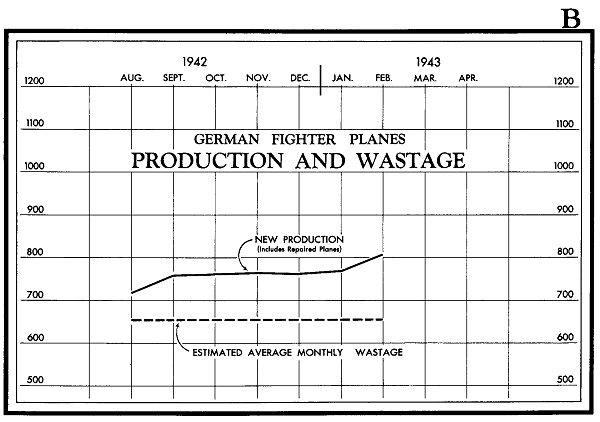

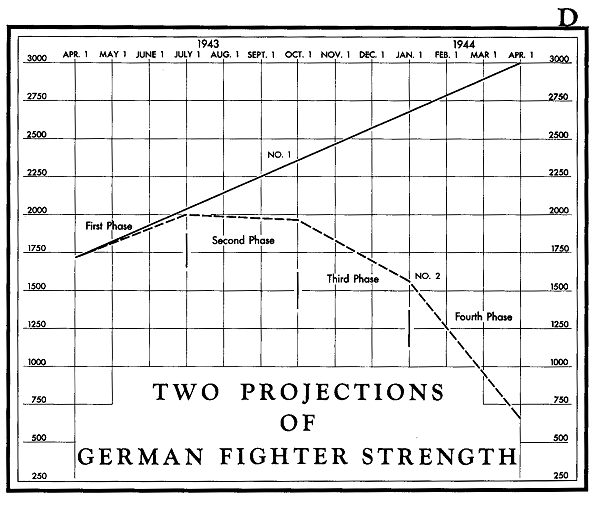
-- -- -- -- -- -- -- -- -- -- -- -- -- -- -- -- -- -- -- -- -- -- -- -- -- -- -- -- -- -- -- -- -- -- -- -- -- -- -- -- -- -- -- -- -- -- -- -- -- --
